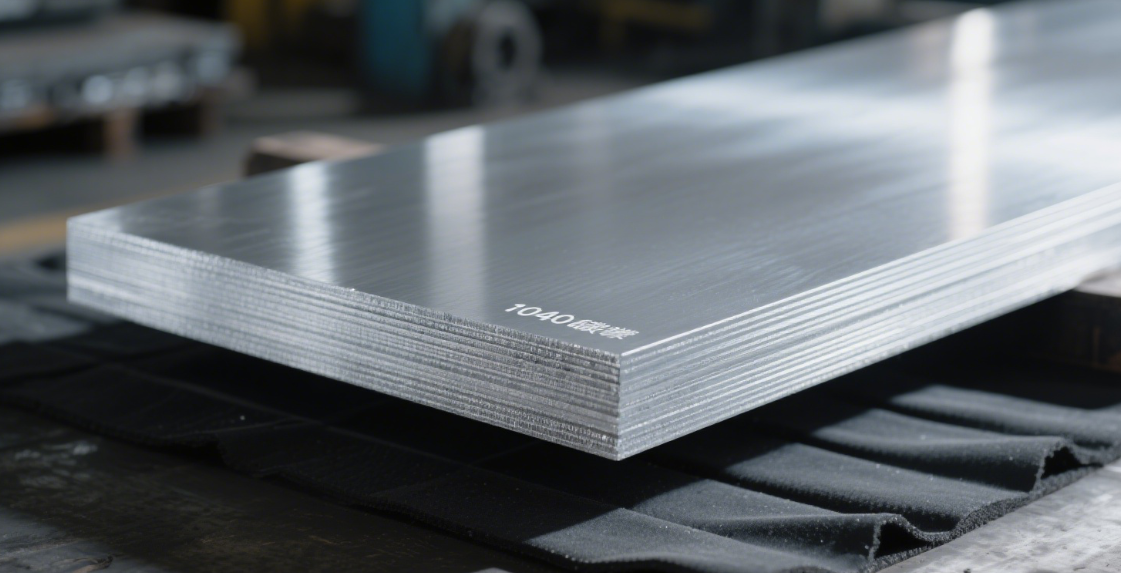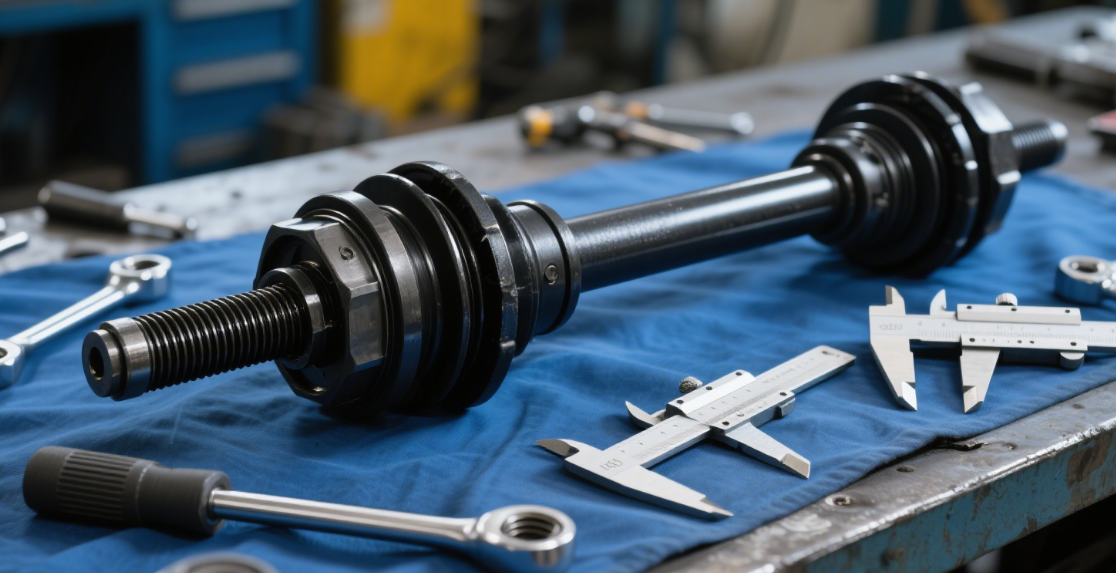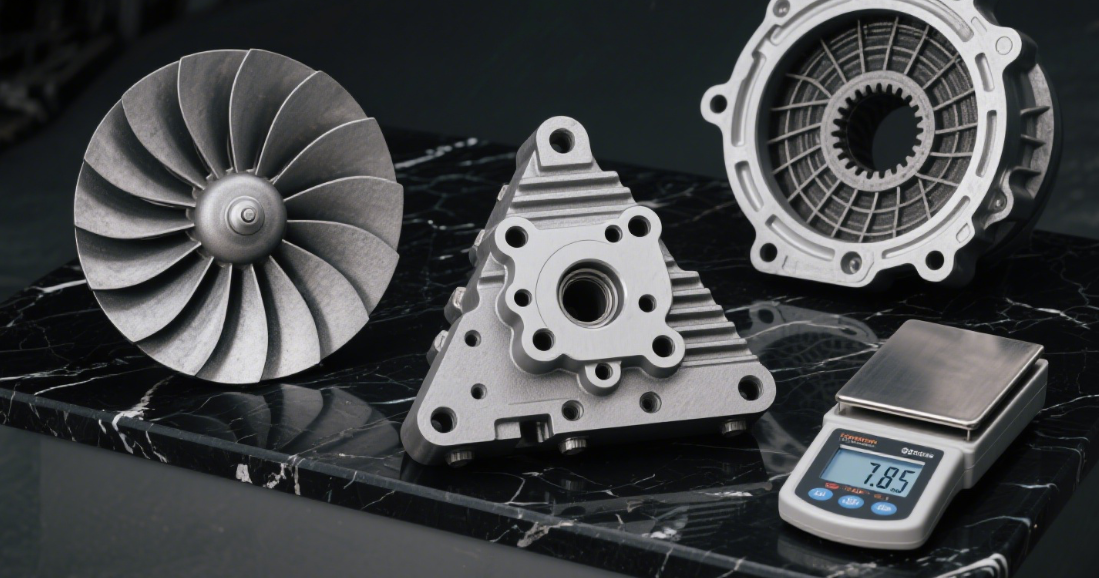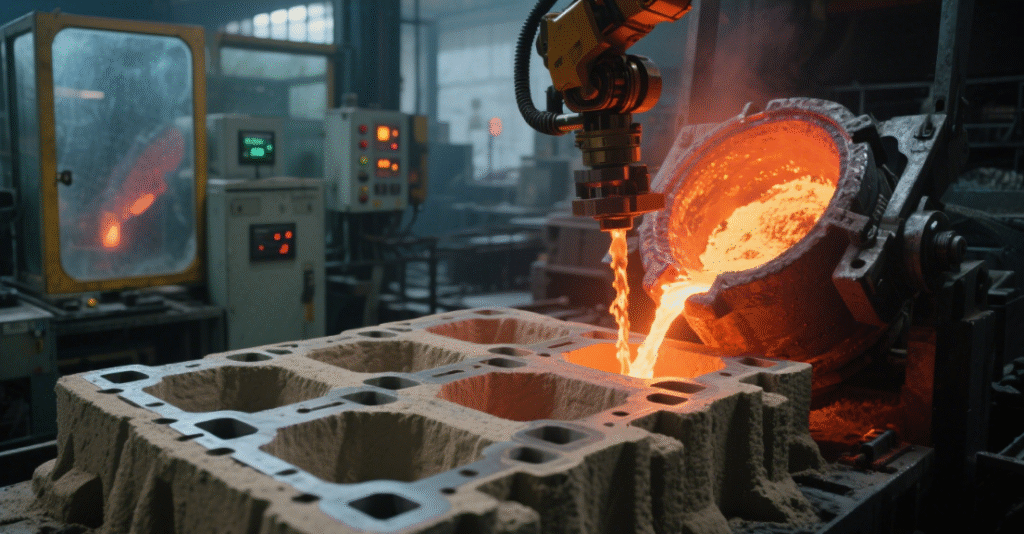Was ist 1040 Kohlenstoffstahl? Ein umfassender Leitfaden
In the vast world of carbon steels, 1040 Kohlenstoffstahl stands out as a versatile and widely used material, especially in mechanical and industrial applications. Known for its excellent balance of strength, hardness, and machinability, this medium-carbon steel alloy is a go-to choice for engineers, manufacturers, and metallurgists alike.
This comprehensive guide aims to provide an in-depth understanding of 1040 Kohlenstoffstahl, exploring its chemical composition, mechanical properties, applications, heat treatment options, and advantages in casting or forging processes. Whether you’re a mechanical engineer, a materials scientist, or someone interested in manufacturing processes, this article will offer valuable insights into the characteristics and utility of 1040 Kohlenstoffstahl.
Inhaltsverzeichnis
Einführung

1040 Kohlenstoffstahl is a medium-carbon steel grade that belongs to the 10xx series of plain carbon steels. The “10” at the beginning indicates it is a plain carbon steel without any significant alloying elements, while the “40” refers to the approximate carbon content — about 0.40% by weight.
This carbon content places 1040 Kohlenstoffstahl in the medium-carbon range, which means it offers a balance between ductility and strength. It can be heat-treated to enhance its mechanical properties, making it suitable for a wide range of engineering applications.
Unlike low-carbon steels that are easy to form but lack strength, or high-carbon steels that are hard but brittle, 1040 Kohlenstoffstahl strikes a balance. It is commonly used in the production of mechanical parts such as axles, gears, crankshafts, and connecting rods.
Chemical Composition and Mechanical Properties of 1040 Carbon Steel
Chemical Composition
| Element | Composition (%) |
|---|---|
| Kohlenstoff (C) | 0.37 – 0.44 |
| Mangan (Mn) | 0.60 – 0.90 |
| Phosphor (P) | ≤ 0.04 |
| Schwefel (S) | ≤ 0.05 |
| Silicon (Si) | 0.15 – 0.35 |
| Iron (Fe) | Balance |
The presence of manganese in 1040 Kohlenstoffstahl enhances its strength and wear resistance, while also improving hot workability. Silicon contributes to deoxidation during the steelmaking process and slightly increases strength.
Mechanical Properties
| Eigentum | Value |
|---|---|
| Tensile Strength | 620 – 850 MPa |
| Yield Strength | 410 – 750 MPa |
| Elongation at Break | 20 – 25% |
| Hardness (Brinell) | 170 – 210 HB |
| Density | 7.85 g/cm³ |
| Modulus of Elasticity | 200 GPa |
These properties make 1040 Kohlenstoffstahl suitable for parts that require moderate strength and resistance to wear. It also maintains good toughness and fatigue resistance, especially when heat-treated properly.
Applications of 1040 Carbon Steel

The unique combination of strength, ductility, and machinability makes 1040 Kohlenstoffstahl a popular choice in many industries. Here are some of the most common applications:
Automobilkomponenten
One of the primary applications of 1040 carbon steel is in the automotive industry. Its strength and machinability make it ideal for manufacturing parts such as:
- Axles
- Getriebe
- Connecting rods
- Crankshafts
- Steering components
These parts require materials that can withstand high stress and fatigue while being cost-effective and easy to machine. 1040 steel can be heat-treated (e.g., quenching and tempering) to enhance surface hardness and wear resistance, which is crucial for moving mechanical parts.
Structural and Machinery Parts
Due to its moderate strength and good weldability, 1040 steel is commonly used in structural applications and general machinery:
- Shafts and spindles
- Bushings and pins
- Machine frames and bases
- Support structures in industrial equipment
It is often selected over low-carbon steels when higher strength is needed without the increased cost or brittleness associated with high-carbon steels.
Agricultural and Construction Equipment
In equipment used in agriculture and construction, parts are often subjected to wear, impact, and environmental exposure. 1040 steel is used to fabricate:
- Plow blades
- Hydraulic cylinder rods
- Trailer hitches
- Loader arms and brackets
These applications benefit from the material’s ability to be heat-treated for surface hardness while maintaining a tough core to absorb shocks.
Custom Fabrications and Replacement Parts
Because of its ease of machining and welding, 1040 carbon steel is often used in custom manufacturing and repair applications:
- Replacement parts for industrial machinery
- Custom shafts and bushings
- Prototype components
Its versatility makes it a go-to material for small-scale production and maintenance operations where high-volume alloys may not be cost-effective.
Heat Treatment and Machinability of 1040 Carbon Steel

1040 Kohlenstoffstahl, known for its balanced mechanical properties, is highly favored in various industrial applications due to its ability to respond well to heat treatment. Heat treatment significantly enhances its strength, hardness, and overall performance, making it suitable for a wide range of parts and components. Below, we delve deeper into the different heat treatment processes, as well as the machinability characteristics of 1040 Kohlenstoffstahl.
Annealing
Annealing is a process used to soften 1040 Kohlenstoffstahl, making it easier to machine, form, or weld. The typical annealing temperature for this steel is around 870°C (1600°F). The steel is held at this temperature for a certain period to allow the internal stresses to dissipate. Afterward, it is cooled slowly in a furnace or air, which helps to refine its grain structure, improve its ductility, and increase its overall workability.
Benefits of Annealing:
- Improved Workability: Softens the steel for easier machining or further processing.
- Stress Relief: Reduces residual stresses that may have been introduced during previous manufacturing steps.
- Better Forming Properties: Facilitates the shaping of the steel into desired forms, especially when used in applications like forging or stamping.
Normalizing
Normalizing is another heat treatment process where 1040 Kohlenstoffstahl is heated to around 890°C (1630°F), then air-cooled. This process refines the steel’s grain structure, improving the mechanical properties and making the material more uniform in terms of strength and hardness. The primary goal of normalizing is to eliminate any internal stresses and ensure more consistent material performance.
Benefits of Normalizing:
- Refined Grain Structure: Helps in improving the overall mechanical properties such as strength, toughness, and hardness.
- Increased Strength and Toughness: Improves the material’s ability to withstand mechanical stress, making it ideal for load-bearing components.
- Improved Workability for Subsequent Processes: By refining the material, normalizing makes it easier to work with during machining, welding, or forming.
Hardening and Tempering
Hardening and tempering are key processes used to increase the hardness and strength of 1040 Kohlenstoffstahl, making it more suitable for high-stress applications. Hardening involves heating the steel to approximately 840–870°C (1540–1600°F) and then rapidly cooling it by quenching in water or oil. The rapid cooling locks the steel’s internal structure into a hardened state. Afterward, the steel is tempered at temperatures between 400–600°C (750–1100°F) to reduce brittleness and achieve the desired balance of hardness and toughness.
Benefits of Hardening and Tempering:
- Enhanced Hardness and Wear Resistance: The process improves the steel’s ability to resist wear and tear, making it ideal for components that will experience high friction or abrasive conditions.
- Improved Toughness: Tempering ensures that the steel remains tough, preventing cracking or breaking under stress.
- Increased Fatigue Resistance: The combination of hardening and tempering also improves the material’s ability to withstand repeated stress cycles, crucial for parts subjected to fatigue loading.
Bearbeitbarkeit
With a machinability rating of around 60% of the standard AISI 1212 steel, 1040 Kohlenstoffstahl is relatively easy to machine, especially in the normalized or annealed condition. It responds well to cutting, drilling, and turning operations.
Advantages of 1040 Carbon Steel in Casting and Forging

1040 Kohlenstoffstahl is considered relatively easy to machine, particularly when it is in the normalized or annealed condition. With a machinability rating of around 60% of the standard AISI 1212 steel, it responds well to typical machining operations such as cutting, drilling, and turning. The machinability of 1040 is further enhanced when it has been properly heat-treated, allowing for smoother and more efficient machining processes.
Machinability Benefits:
- Easier to Machine in Annealed/Normalized Condition: The softer and more uniform structure makes it easier to machine with standard tools.
- Good Surface Finish: Proper machining processes can produce high-quality surface finishes, making it ideal for precision components.
- Cost-Effective: Thanks to its good machinability, 1040 Kohlenstoffstahl can be processed with standard cutting tools and machinery, reducing overall production costs.
Forging Benefits
- High Ductility and Strength: Allows for complex shaping without cracking.
- Good Flow Characteristics: Ensures consistent grain structure and mechanical properties.
- Excellent Response to Heat Treatment: Enhances wear resistance and fatigue life.
Forged parts made from 1040 Kohlenstoffstahl are commonly found in automotive and aerospace components where reliability and longevity are critical.
Casting Benefits
- Lower Cost for Complex Shapes: Casting allows for the production of intricate parts without expensive machining.
- Good Dimensional Stability: Maintains shape and size after cooling.
- Uniform Microstructure: Leads to predictable mechanical behavior.
In casting, 1040 Kohlenstoffstahl can be used to produce large, complex components that would be difficult to manufacture via other methods.
Comparison of 1040 Steel with Other Steel Grades
| Eigentum | 1020 Steel | 1040 Steel | 1060 Steel |
|---|---|---|---|
| Carbon Content | 0.18 – 0.25% | 0.37 – 0.44% | 0.55 – 0.65% |
| Stärke | Niedrig | Medium | Hoch |
| Ductility | Hoch | Medium | Niedrig |
| Wear Resistance | Niedrig | Medium-High | Hoch |
| Bearbeitbarkeit | Exzellent | Gut | Fair |
| Typical Use | Strukturelle Bauteile | Shafts, Gears | Springs, Blades |
This comparison highlights the versatility of 1040 Kohlenstoffstahl — it offers a good compromise between strength and machinability, making it suitable for a wide range of applications.
Häufig gestellte Fragen
1. What is 1040 Carbon Steel used for?
1040 Kohlenstoffstahl is commonly used in the manufacture of crankshafts, gears, axles, connecting rods, and other mechanical parts that require moderate strength and wear resistance.
2. Is 1040 Kohlenstoffstahl weldable?
Yes, 1040 Kohlenstoffstahl can be welded, though preheating and post-weld heat treatment are often recommended to prevent cracking and maintain mechanical properties.
3. Can 1040 Carbon Steel be hardened?
Yes, 1040 Kohlenstoffstahl responds well to heat treatment. It can be hardened through quenching and tempering, which significantly increases its surface hardness and strength.
4. What is the difference between 1040 and 4140 steel?
Während 1040 Kohlenstoffstahl is a plain carbon steel, 4140 Steel is an alloy steel containing chromium and molybdenum. This gives 4140 superior toughness and strength, especially at elevated temperatures.
5. Is 1040 Kohlenstoffstahl suitable for casting?
Yes, 1040 Kohlenstoffstahl is suitable for casting, especially for large or complex components. Its good flowability and dimensional stability make it ideal for cast applications.
6. Does 1040 Carbon Steel rust?
Like all carbon steels, 1040 Kohlenstoffstahl is susceptible to rust and corrosion when exposed to moisture and oxygen. Protective coatings or plating are recommended for outdoor or corrosive environments.
Abschluss
1040 Kohlenstoffstahl offers a compelling combination of strength, ductility, and machinability, making it a preferred material across various industries. Whether you’re designing automotive components, industrial machinery, or durable mechanical parts, 1040 Kohlenstoffstahl provides a reliable and cost-effective solution.
Its ability to be heat-treated, forged, and even cast further enhances its versatility. While it may not be the strongest or hardest steel available, its balanced properties ensure that it remains a staple in modern engineering and manufacturing.
As industries continue to evolve and demand more from materials, 1040 Kohlenstoffstahl remains a trusted choice — a testament to its enduring value in mechanical design and industrial applications.
Bleiben Sie mit uns in Verbindung

Vielen Dank fürs Lesen! Wir hoffen, dieser Blogbeitrag hat Ihnen wertvolle Einblicke und Inspirationen zum Thema Akustikdecken gegeben. Wenn Ihnen der Inhalt gefallen hat und Sie über die neuesten Trends, Tipps und Einblicke hinter die Kulissen auf dem Laufenden bleiben möchten, würden wir uns freuen, mit Ihnen über die sozialen Medien in Kontakt zu treten.
📘 Folgen Sie uns auf Facebook: Shanghai Leierwo Industriehandel Co., Ltd.
Treten Sie unserer wachsenden Community bei, in der wir Expertenratschläge, Produkthighlights und interaktive Diskussionen mit Fachleuten und Design-Enthusiasten aus der ganzen Welt teilen.
Lassen Sie uns das Gespräch fortsetzen – wir sehen uns dort!
Produktkategorien
- Ventilteile
- Wasserpumpenteile
- Lagergehäuseteile
- Druckgussteile
- Pumpenprodukte aus Edelstahl
- Pumpenprodukte aus Gusseisen
- Ventilteile für den Automobilgebrauch
- Autoteile
- Ventilteile für den zivilen Gebrauch
- Vakuumpumpenteile KF

